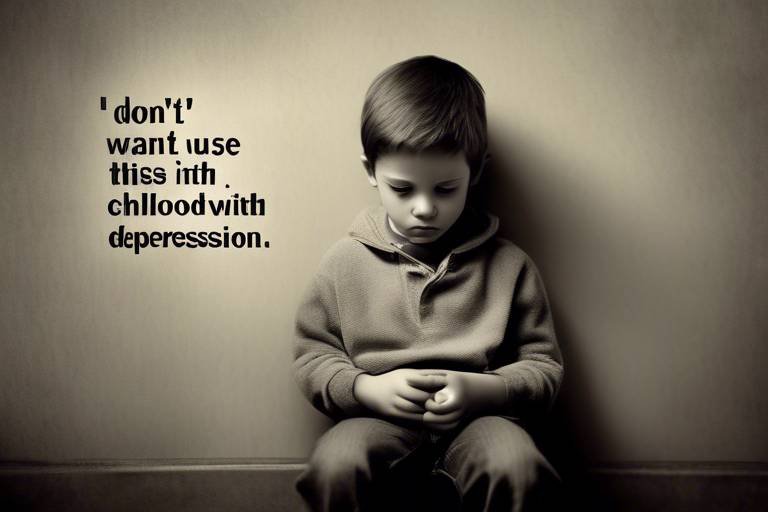Effective Parenting Strategies for the Digital Age
In today's fast-paced world, where technology is woven into the fabric of our daily lives, parenting has taken on a whole new dimension. The digital age presents a unique set of challenges and opportunities that can significantly impact our children. As parents, we must navigate this complex landscape, ensuring that our kids not only thrive but also develop healthy habits in their digital interactions. Effective parenting strategies are essential to foster strong family connections while managing the influence of screens and technology.
Before diving into strategies, it's crucial to understand how digital media affects children's development. The pervasive presence of technology shapes their behavior, learning processes, and social interactions. Children today are exposed to a constant stream of information, which can be both enlightening and overwhelming. For instance, studies reveal that excessive screen time can lead to issues like reduced attention spans and difficulties in social communication. As parents, recognizing these influences is the first step toward creating a balanced environment where technology enhances rather than hinders growth.
One of the most effective ways to navigate the digital landscape is by establishing appropriate screen time limits. Just like a balanced diet is crucial for physical health, a balanced approach to screen time is vital for mental and emotional well-being. But how do we strike that balance? It starts with open conversations about the importance of both digital and real-world interactions. Setting clear boundaries can help children understand that while technology is a valuable tool, it should not dominate their lives. Here are some strategies to consider:
A family media plan acts as a roadmap for technology use within the household. This personalized plan should reflect your family's values and lifestyle. To create an effective media plan, involve your children in the discussion. Ask them about their favorite activities and how they feel about screen time. Together, you can outline specific guidelines that everyone agrees upon. This collaborative approach not only fosters a sense of responsibility but also empowers children to make informed decisions about their media consumption.
Selecting age-appropriate and educational content is crucial for children's media consumption. With a plethora of options available, it can be daunting to curate suitable media choices. Parents should take an active role in this process by exploring various platforms and resources. Consider utilizing tools like Common Sense Media, which provides ratings and reviews for movies, games, and apps based on age appropriateness. By guiding your children towards enriching content, you can enhance their learning experiences while ensuring their safety.
Promoting offline activities is another effective way to foster creativity and social skills. In a world dominated by screens, it's easy to forget the joys of hands-on experiences. Encourage your children to engage in activities such as:
- Reading books together
- Exploring nature through hikes or bike rides
- Participating in arts and crafts
- Playing board games as a family
These activities not only strengthen family bonds but also help children develop vital life skills that screens cannot provide.
Keeping track of children's online activities is vital for their safety. However, monitoring doesn't mean invading their privacy. Open communication is key. Discuss the importance of online safety and establish trust with your children. Utilize parental control tools that allow you to set limits without being overly intrusive. This way, you can ensure a safe online environment while allowing your kids the freedom to explore and learn.
In an era where information is at our fingertips, teaching children how to navigate the digital world responsibly is essential. Digital literacy goes beyond knowing how to use devices; it encompasses critical thinking, online safety, and ethical behavior. By fostering these skills, you're equipping your children to become informed and responsible digital citizens.
Educating children about online safety and cybersecurity is paramount. Start by explaining key concepts such as:
- Creating strong passwords
- Recognizing phishing scams
- Understanding privacy settings on social media
By instilling these practices early on, you help protect them from potential threats and encourage a proactive approach to their online presence.
Fostering critical thinking skills enables children to analyze the information they encounter online. Encourage them to question the validity of sources and to think critically about the content they consume. Ask open-ended questions like, "What do you think about this article?" or "How does this video make you feel?" This dialogue not only sharpens their analytical skills but also strengthens your relationship as they feel valued in their opinions.
Q: How much screen time is appropriate for children?
A: The American Academy of Pediatrics suggests that children aged 2 to 5 should have no more than one hour of high-quality programming per day, while older children should have consistent limits that allow for healthy activities.
Q: How can I talk to my child about online safety?
A: Start by having open discussions about their online experiences, emphasizing the importance of privacy and safety. Use real-life examples to illustrate potential risks.
Q: What are some good offline activities for kids?
A: Encourage activities like reading, sports, arts and crafts, and family outings to help balance screen time with enriching experiences.

Understanding Digital Influence
In today's fast-paced world, the impact of digital media on children cannot be overstated. As parents, it’s essential to recognize how technology shapes our kids' behavior, learning, and social interactions. From the moment they pick up a tablet or smartphone, children are exposed to a vast array of information and experiences that can significantly influence their development. But what does this really mean for their growth and well-being?
First off, let's talk about behavioral changes. Studies have shown that excessive screen time can lead to a variety of behavioral issues, including increased aggression, anxiety, and even depression. Imagine a child who spends hours glued to a screen – they may struggle to engage in face-to-face conversations or develop crucial social skills. This is where parents need to step in and guide their children towards a more balanced lifestyle.
Next, consider the educational aspects of technology. While there are countless educational apps and programs designed to enhance learning, not all digital content is created equal. It’s vital for parents to sift through the digital noise and find resources that truly benefit their child's education. For instance, interactive learning games can be a great way to make learning fun, but they should be complemented with traditional study methods. This balance is key to fostering a well-rounded education.
Social interactions are another area where digital influence is profound. Children often communicate through social media and messaging apps rather than face-to-face conversations. This shift can lead to a lack of empathy and understanding of social cues. Parents should encourage their kids to engage in real-life interactions, fostering emotional intelligence and strong interpersonal skills. After all, nothing beats the warmth of a genuine smile or the comfort of a shared laugh in person.
To summarize, understanding the digital influence on children's development means acknowledging both the positive and negative aspects of technology. Here are a few critical points to keep in mind:
- Behavioral Impact: Excessive screen time can lead to behavioral issues.
- Educational Value: Not all digital content is beneficial; choose wisely.
- Social Skills: Encourage real-life interactions to develop empathy and communication skills.
As we navigate this digital landscape, it’s crucial for parents to stay informed and proactive. By understanding the multifaceted influence of technology, we can better equip our children to thrive in both the digital world and the real one. So, are you ready to take on the challenge and help your kids grow into responsible digital citizens?

Setting Screen Time Limits
In today's fast-paced digital landscape, setting screen time limits for children is more crucial than ever. With the allure of smartphones, tablets, and gaming consoles, it's easy for kids to get lost in the digital world, often at the expense of real-life interactions and activities. But how do we strike that perfect balance? It’s not just about saying “no” to screens; it’s about creating a healthy relationship with technology. By establishing clear boundaries, parents can help their children develop a sense of responsibility and self-regulation when it comes to their screen time.
First and foremost, it’s essential to understand that screen time isn’t inherently bad. In fact, it can be a valuable tool for learning and socialization. However, without limits, it can lead to issues such as reduced physical activity, disrupted sleep patterns, and even social isolation. So, how can parents effectively implement screen time limits? Here are a few strategies that can help:
- Communicate Openly: Discuss the reasons behind screen time limits with your children. Explain how too much screen time can affect their health and well-being.
- Be Consistent: Set clear and consistent rules regarding screen time. For instance, you might decide that screens are not allowed during family meals or before bedtime.
- Lead by Example: Children often mimic their parents' behaviors. If you model healthy screen habits, they are more likely to follow suit.
Creating a family media plan can also be a game changer. This plan should outline the amount of screen time allowed each day and the types of content that are acceptable. For instance, educational programs may be prioritized over mindless entertainment. By involving your children in this planning process, you not only empower them but also encourage them to take ownership of their media consumption.
Moreover, consider using tools and apps that help monitor and limit screen time. Many devices now come with built-in features that allow parents to set time limits or restrict access to certain applications. This way, you can ensure that your children are engaging with technology in a balanced manner, without the constant battle over screen time.
Lastly, remember to encourage offline activities. Whether it’s sports, reading, or arts and crafts, providing your children with alternative activities can help reduce their reliance on screens. The goal is to create a diverse range of interests that keep them engaged without the need for digital devices. With a little creativity, you can turn family time into a tech-free zone where meaningful connections thrive.
In conclusion, setting screen time limits is not just about restriction; it’s about fostering a healthy relationship with technology that benefits the entire family. By establishing clear guidelines, communicating openly, and encouraging offline activities, parents can help their children navigate the digital age with confidence and balance.
Q: How much screen time is considered appropriate for children?
A: The American Academy of Pediatrics recommends that children aged 2 to 5 should have no more than one hour of high-quality programming each day, while children aged 6 and older should have consistent limits on screen time to ensure sufficient time for sleep, physical activity, and other healthy behaviors.
Q: What are some signs that my child may be spending too much time on screens?
A: Signs may include irritability when not using screens, difficulty concentrating, disrupted sleep patterns, and a decline in physical activity or social interactions.
Q: How can I encourage my child to engage in offline activities?
A: Introduce them to various hobbies, schedule family outings, or create a challenge that encourages them to try new things, whether it’s sports, arts, or reading. Making offline activities fun and engaging is key!

Creating a Family Media Plan
In today's fast-paced digital world, crafting a Family Media Plan is like drawing a roadmap for your family's journey through technology. It’s essential to ensure that everyone is on the same page when it comes to technology use, and that we foster a healthy relationship with digital media. So, how do you get started? First, gather the family together for a fun and open discussion. This isn’t just about setting rules; it’s about creating a shared understanding of how technology fits into your lives.
Begin by assessing your family's current media habits. Ask questions like: How much time do we spend on screens each day? and What types of content are we consuming? A great way to visualize this is by creating a simple table that outlines daily screen time across various devices. This can help identify patterns and areas for improvement.
| Device | Average Daily Usage (Hours) |
|---|---|
| Smartphones | 3 |
| Tablets | 2 |
| Television | 2.5 |
| Computers | 2 |
Once you have a clearer picture, it’s time to set some guidelines. These should be realistic and take into account the ages and interests of your children. For instance, younger kids might benefit from shorter screen time limits, while teens may require more flexibility. Discuss and agree on specific time slots for media use, such as no screens during meals or family time. These boundaries help reinforce the importance of face-to-face interactions.
Another key aspect of your Family Media Plan is content selection. Talk about what types of shows, games, and apps are appropriate for each family member. It's essential to prioritize educational and age-appropriate content. You might even consider creating a shared playlist of favorite shows or games that everyone can enjoy together. This not only encourages family bonding but also helps kids understand the value of quality content over quantity.
To make the plan more engaging, consider incorporating family media nights where everyone can share their favorite shows or games. This can transform screen time from a solitary activity into a bonding experience, allowing you to discuss what everyone is watching or playing and why they enjoy it.
Lastly, remember that a Family Media Plan is not set in stone. It's a living document that should evolve as your family grows and technology changes. Regular check-ins can help you adjust the plan to meet new challenges or interests. Encourage your children to express their thoughts on the plan, fostering a sense of ownership and responsibility towards their media consumption. This collaborative approach makes it easier to navigate the digital landscape together.
In conclusion, creating a Family Media Plan is about striking a balance between embracing technology and maintaining healthy family dynamics. By setting clear guidelines, choosing appropriate content, and fostering open communication, you can ensure that your family thrives in the digital age.
- What is a Family Media Plan? A Family Media Plan is a set of guidelines that helps families manage their technology use, ensuring a healthy balance between digital and real-world interactions.
- How often should we revisit our Family Media Plan? It's advisable to revisit the plan at least once a year or whenever there are significant changes in your family's media habits or technology landscape.
- Can I involve my children in creating the plan? Absolutely! Involving your children fosters a sense of responsibility and helps them understand the importance of healthy media consumption.
- What should we do if someone breaks the rules? Use it as a teaching moment. Discuss what happened and why it’s important to stick to the plan, and adjust the rules if necessary.

Choosing Appropriate Content
When it comes to our children's media consumption, is crucial. The digital landscape is vast, filled with both enriching and potentially harmful material. As parents, we have the responsibility to guide our children through this maze, ensuring they engage with content that is not only age-appropriate but also educational and beneficial for their development. So, how can we navigate this complex world of digital media?
First, it's important to understand the different types of content available. There are educational programs, interactive games, and creative apps that can enhance learning and creativity. However, there are also shows and games that may promote violence or unhealthy behaviors. To make informed choices, consider the following:
- Age Ratings: Always check the age ratings provided by platforms. These ratings can give you a quick insight into whether the content is suitable for your child's age group.
- Content Reviews: Look for reviews from trusted sources, such as educational websites or parenting blogs. These reviews can provide valuable insights into the content's appropriateness and educational value.
- Educational Value: Prioritize content that promotes learning. Look for programs that teach critical thinking, problem-solving, and creativity.
Another effective strategy is to co-view media with your children. Watching together not only allows you to monitor what they are consuming but also opens up opportunities for discussion. You can ask questions like, “What do you think about that character's choices?” or “How would you handle that situation differently?” This not only helps you gauge their understanding but also encourages them to think critically about the content they are exposed to.
Moreover, consider creating a list of approved shows, games, and apps that your children can access. This list can serve as a helpful guide, ensuring that they have a selection of quality content to choose from. You might want to involve your children in this process, allowing them to express their interests while ensuring that the options remain within the boundaries of appropriateness.
Lastly, remember that the digital world is ever-evolving. New content is constantly being created, and what may have been suitable last year could be outdated or inappropriate today. Regularly revisiting your media choices and having open conversations with your children about their media consumption is essential to maintain a healthy balance.
By being proactive and involved in your children's media choices, you can help foster a positive digital environment that enhances their development while keeping them safe from potentially harmful influences.
Q1: How do I know if a show is appropriate for my child?
A1: Check the age rating, read reviews, and consider the educational value. Watching the show together can also help you assess its appropriateness.
Q2: What should I do if my child wants to watch something I deem inappropriate?
A2: Have an open conversation about your concerns. Explain why you think it's not suitable, and suggest alternative content that aligns with their interests.
Q3: How can I encourage my child to choose educational content?
A3: Create a list of approved educational shows and apps, and involve your child in the selection process. Discuss the benefits of educational content during your media time together.

Encouraging Offline Activities
In today's fast-paced digital world, it's all too easy for children to become glued to their screens, losing touch with the vibrant, real-world experiences that shape their growth and development. As parents, it's crucial to encourage offline activities that not only foster creativity but also enhance social skills and physical health. Think of it like a garden; just as plants need sunlight and nutrients to thrive, children need a variety of experiences to flourish. By promoting offline activities, you’re giving them the sunlight they need to grow into well-rounded individuals.
One way to encourage offline activities is to create a structured schedule that includes time for both digital and non-digital pursuits. However, it’s essential to keep it flexible and fun! For instance, consider setting aside certain hours during the week as "screen-free time." During this time, families can engage in various activities together, such as playing board games, going for a hike, or even cooking a meal. These moments not only strengthen family bonds but also teach valuable life skills.
Additionally, you can introduce your children to hobbies that spark their interest and creativity. Activities like painting, gardening, or building models can be incredibly fulfilling. When children engage in hands-on activities, they learn to express themselves in ways that screens simply can't replicate. For example, while a video game might provide instant gratification, creating a piece of art or a model airplane offers a sense of accomplishment that lasts much longer.
Moreover, sports and outdoor games are fantastic for promoting physical activity and teamwork. Whether it’s a game of soccer in the backyard or a neighborhood bike ride, these activities encourage children to engage with their peers in a healthy, active way. Plus, they get to experience the joy of movement, fresh air, and the beauty of nature, which are all vital for their overall well-being.
It's also important to lead by example. If children see their parents engaging in offline activities, they are more likely to mimic that behavior. Consider starting a family tradition, like a weekly hike or a monthly craft night. Not only will this provide quality time together, but it will also create lasting memories that your children will cherish. Remember, the goal is not to completely eliminate screen time but to strike a balance that allows for a rich tapestry of experiences.
In conclusion, encouraging offline activities is about creating a well-rounded lifestyle for your children. By incorporating a variety of engaging, hands-on experiences into their daily routines, you’re not just helping them disconnect from screens; you’re also equipping them with essential skills and a deeper appreciation for the world around them. So, let’s get out there and explore the endless possibilities that await beyond the screen!
Q: How much screen time is considered healthy for children?
A: The American Academy of Pediatrics recommends that children aged 2 to 5 should have no more than one hour of high-quality programming per day, while children aged 6 and older should have consistent limits on the amount of time spent using screens, ensuring it does not interfere with sleep, physical activity, and other healthy behaviors.
Q: What are some offline activities that can engage my child?
A: Some engaging offline activities include arts and crafts, sports, reading books, playing musical instruments, gardening, cooking, and exploring nature through hikes or outdoor games.
Q: How can I motivate my child to participate in offline activities?
A: Start by participating in activities that interest them, create a fun and inviting environment, and provide positive reinforcement. Additionally, consider scheduling regular family activities to encourage participation.

Monitoring Online Behavior
In today's digital landscape, monitoring your child's online behavior is not just a precaution—it's a necessity. With countless distractions and potential dangers lurking in the vast expanse of the internet, parents must take an active role in ensuring their children's safety while respecting their privacy. Think of it like being a lighthouse keeper; your job is to guide them safely through the stormy seas of the online world without smothering their independence.
To effectively monitor online behavior, parents can utilize a combination of tools and techniques. First and foremost, open communication is key. Create an environment where your child feels comfortable discussing their online activities. Ask them about their favorite websites, the games they play, and the friends they interact with online. This not only helps you stay informed but also builds trust between you and your child.
Moreover, consider using parental control software. These tools can help you manage and monitor your child's online interactions without being overly intrusive. For instance, you can set limits on screen time, block inappropriate content, and even track their online activity. However, it’s crucial to strike a balance. Over-monitoring can lead to feelings of resentment and rebellion, much like a teenager pushing back against a curfew. Instead, aim to use these tools as a means of guidance rather than control.
Here's a quick overview of some effective monitoring techniques:
| Technique | Description |
|---|---|
| Open Dialogue | Encourage conversations about online experiences and feelings. |
| Parental Control Software | Utilize apps to manage screen time and filter content. |
| Regular Check-ins | Schedule routine discussions about online activities and friends. |
Additionally, it's essential to educate your child about the importance of online privacy. Teach them to recognize red flags, such as unsolicited messages or requests for personal information. By instilling these values early on, you're not just protecting them; you're empowering them to make wise decisions in the digital realm. Remind them that the internet, while a fantastic resource, can also be a breeding ground for negativity and danger.
Finally, remember to lead by example. Your own online behavior sets a precedent for your children. Show them how to navigate social media responsibly, respect others online, and maintain a healthy balance between digital interactions and real-life relationships. It's a journey, and by walking alongside them, you're not just monitoring their behavior; you're actively participating in their growth and development.
- How can I start a conversation with my child about online safety? Begin by asking about their favorite websites and games, then share your own experiences and concerns.
- What are the best parental control apps? Some popular options include Qustodio, Norton Family, and Net Nanny, which offer various features for monitoring and managing online behavior.
- How do I respect my child's privacy while monitoring their online activity? Focus on communication and transparency. Involve them in discussions about monitoring and explain why it's necessary for their safety.

Promoting Digital Literacy
In our fast-paced, technology-driven world, among children has become more essential than ever. It's not just about knowing how to use devices; it's about understanding how to navigate the vast ocean of information available online. Think of it as teaching your child to swim in a pool filled with both treasures and hidden dangers. By equipping them with the right skills, you can ensure they dive into the digital world safely and intelligently.
So, what exactly does digital literacy entail? At its core, it's about being able to find, evaluate, and use information effectively. This means teaching children how to discern credible sources from unreliable ones, a skill that is increasingly important in an age where misinformation can spread like wildfire. For instance, when your child comes across a shocking news article, ask them questions like, "Who wrote this? What are their credentials? Is there any evidence to back this up?" This not only encourages critical thinking but also empowers them to question the information they consume.
Moreover, digital literacy also encompasses understanding online etiquette and the importance of maintaining a positive digital footprint. In today’s world, the things we share online can have lasting consequences. It’s crucial to have conversations about how their online actions, from social media posts to comments on forums, can impact their reputation. Remind them that once something is out there, it’s challenging to take it back. This understanding can guide them to make more thoughtful choices about what they share.
To further enhance their digital literacy, consider incorporating the following practices into your family routine:
- Encourage Exploration: Allow your children to explore different educational websites and apps. This hands-on experience fosters a sense of curiosity and helps them learn how to navigate various platforms.
- Discuss Current Events: Use news articles or videos as a springboard for discussion. Ask your children what they think about the information presented and encourage them to express their opinions.
- Teach Research Skills: Show them how to conduct effective online searches. Discuss keywords, search engines, and how to evaluate the credibility of sources.
Additionally, creating a safe space for open dialogue about their online experiences is vital. Encourage your children to come to you with any questions or concerns they may have about what they encounter on the internet. This not only builds trust but also allows you to guide them through the complexities of digital interactions.
Incorporating digital literacy into your parenting strategy is not just about protecting your children; it’s about empowering them. By fostering these skills, you’re giving them the tools they need to thrive in a digital landscape that is constantly evolving. Think of it as planting seeds in a garden; with the right care and attention, those seeds will grow into strong, resilient plants capable of weathering any storm.
1. What age should I start teaching my child about digital literacy?
Most experts suggest introducing digital literacy concepts as early as elementary school. Start with basic skills and gradually introduce more complex topics as they grow.
2. How can I monitor my child's online activity without invading their privacy?
Open communication is key. Discuss your concerns with your child and set clear boundaries together. Use parental controls as a tool rather than a surveillance method.
3. Are there any resources available to help teach digital literacy?
Absolutely! Many websites and organizations offer free resources, including lesson plans and interactive activities designed to promote digital literacy.
4. How can I encourage my child to think critically about online content?
Engage them in discussions about what they see online. Ask probing questions and encourage them to seek out multiple sources of information before forming an opinion.

Understanding Cybersecurity
In today's digital landscape, understanding cybersecurity is more crucial than ever, especially for our children. It's not just about protecting personal information, but also about fostering a sense of safety and awareness in an online world that can be unpredictable and sometimes perilous. As parents, we must instill in our kids the knowledge and skills they need to navigate this digital realm wisely. Think of it as teaching them to ride a bike; you wouldn't just push them off and hope for the best, right? You'd ensure they understand the rules of the road, how to balance, and the importance of wearing a helmet.
Start by discussing the various types of online threats that children may encounter, such as phishing scams, malware, and cyberbullying. These are not just buzzwords; they represent real dangers that can affect your child's emotional and psychological well-being. For instance, phishing scams often masquerade as legitimate emails or messages, tricking users into providing sensitive information. It's essential to explain to your kids that if something seems too good to be true, it probably is. By fostering an environment where they feel comfortable asking questions, you can help them develop a healthy skepticism towards suspicious online interactions.
One effective way to teach your children about cybersecurity is through interactive discussions. Instead of lecturing them, engage in conversations about their online experiences. Ask them about the games they play, the apps they use, and the people they interact with. This not only keeps you informed but also opens the door for teaching moments. For example, if your child mentions a new game that requires personal information, seize the opportunity to explain why sharing such details can be dangerous.
In addition, consider creating a simple set of cybersecurity rules that your family can follow. Here’s a quick overview:
- Use Strong Passwords: Teach your kids to create complex passwords and change them regularly.
- Be Wary of Public Wi-Fi: Explain the risks of using unsecured networks and encourage them to avoid accessing sensitive information on public Wi-Fi.
- Think Before You Click: Encourage them to be cautious with links and attachments in emails or messages.
- Keep Personal Information Private: Stress the importance of not sharing personal details like addresses, phone numbers, or school names online.
Moreover, it's beneficial to introduce your children to the concept of digital footprints. Help them understand that everything they do online leaves a mark. This awareness can be a powerful motivator for them to act responsibly. A simple analogy could be comparing their online behavior to a public diary; once something is posted, it can be challenging to erase it entirely. Encourage them to think critically about what they share and how it reflects on their character.
Lastly, consider utilizing tools and resources designed to enhance online safety. There are various parental control apps and software available that can help monitor your child's online activities without infringing on their privacy. These tools can serve as a safety net, allowing you to guide them while still granting them the freedom to explore the digital world. Remember, the goal is not to create an atmosphere of fear but rather to empower your children with the knowledge and skills they need to stay safe online.
Q: What is cybersecurity?
A: Cybersecurity refers to the practice of protecting computers, networks, and data from unauthorized access or attacks. It's essential for ensuring the safety of personal and sensitive information online.
Q: How can I teach my child about online safety?
A: Start by having open conversations about their online activities, discussing potential threats, and establishing a set of cybersecurity rules. Use real-life examples to illustrate the importance of being cautious online.
Q: Are parental control apps effective?
A: Yes, parental control apps can be effective tools for monitoring online activity and ensuring your child's safety. However, they should be used as part of a broader strategy that includes education and open communication.
Q: What should I do if my child encounters cyberbullying?
A: Encourage your child to talk to you about it immediately. Discuss the situation, and help them report the bullying to the appropriate platform. Support them emotionally and reassure them that they are not alone.

Encouraging Critical Thinking
In a world overflowing with information, teaching children to think critically is more important than ever. With a click of a button, they can access a plethora of data, opinions, and media, but how can they differentiate between fact and fiction? This is where critical thinking comes into play. It’s not just about absorbing information; it’s about questioning it, analyzing it, and forming their own opinions. So, how can we, as parents, foster this essential skill in our children?
One effective approach is to create an environment that encourages questioning. Instead of simply providing answers, engage your children in discussions that prompt them to think deeper. For example, when they come across a news article or a social media post, ask them open-ended questions like, “What do you think the author’s point of view is?” or “What evidence supports this claim?” These questions not only stimulate their curiosity but also help them to articulate their thoughts and opinions.
Additionally, introducing them to various perspectives can significantly enhance their critical thinking abilities. Encourage them to explore multiple sources of information on the same topic. For instance, if they’re interested in a current event, guide them to read articles from different news outlets. This practice will help them understand that there are often multiple sides to a story, and they must evaluate the credibility of each source. To make this process easier, you might consider creating a simple table to compare the different viewpoints:
| Source | Perspective | Credibility |
|---|---|---|
| Source A | Supports the event | High |
| Source B | Opposes the event | Medium |
| Source C | Neutral stance | High |
Moreover, integrating critical thinking into everyday activities can be a fun and engaging way to reinforce these skills. For instance, when watching a movie or a TV show together, pause the screen and ask your child what they think will happen next and why. This not only makes the viewing experience interactive but also encourages them to analyze character motivations and plot developments.
Lastly, it’s essential to model critical thinking in your own life. Share your thought processes with your children when making decisions or solving problems. Let them see how you weigh options, consider consequences, and evaluate information. This transparency will teach them that critical thinking is a valuable life skill, not just an academic exercise. Remember, the goal is to equip them with the tools they need to navigate the digital age with discernment and confidence.
- What is critical thinking? Critical thinking is the ability to analyze information objectively and make a reasoned judgment. It involves evaluating sources, identifying biases, and drawing conclusions based on evidence.
- Why is critical thinking important for children? In today's digital age, children are bombarded with information. Critical thinking helps them discern credible sources from unreliable ones, fostering informed decision-making.
- How can I encourage my child to think critically? Engage them in discussions, ask open-ended questions, expose them to different perspectives, and model critical thinking in your own life.
Frequently Asked Questions
- What are some effective strategies for setting screen time limits?
Setting screen time limits can be challenging, but it's crucial for maintaining a healthy balance. Start by having open discussions with your kids about the importance of limits. Use tools like timers or apps to help monitor their usage. Also, consider creating a family media plan that outlines specific times for screen use, ensuring everyone is on the same page.
- How can I create a family media plan?
Creating a family media plan involves discussing your family's values and goals regarding technology use. Sit down together and outline what content is appropriate, how much time is allowed, and what offline activities can be included. This collaborative approach not only sets clear expectations but also fosters a sense of responsibility among children.
- What types of offline activities can help reduce screen dependency?
Encouraging offline activities can be a game-changer! Think about family game nights, outdoor adventures, or arts and crafts projects. These activities not only promote creativity but also strengthen family bonds. You could even set up a weekly challenge where everyone tries a new offline hobby, making it a fun and engaging experience!
- How do I monitor my child's online behavior without invading their privacy?
Monitoring online behavior is essential, but it’s all about balance. Use parental control tools that provide insights without being overly intrusive. Engage in conversations about their online experiences, encouraging them to share without feeling like they're being watched. This builds trust and allows you to guide them safely through the digital world.
- What is digital literacy, and why is it important?
Digital literacy is the ability to navigate and critically assess information online. In today's world, it's vital for children to understand how to find reliable sources, recognize misinformation, and communicate responsibly. Teaching digital literacy empowers kids to become informed users of technology, equipping them for a future where digital skills are essential.
- How can I teach my kids about cybersecurity?
Teaching kids about cybersecurity can be fun and engaging! Start with the basics, like creating strong passwords and recognizing phishing attempts. Use relatable examples, like comparing online safety to locking the front door. Incorporate games or quizzes to reinforce these concepts, making them feel empowered to protect themselves online.
- What strategies can I use to encourage critical thinking in my children?
Fostering critical thinking is all about asking the right questions. Encourage your kids to question what they see online by asking, “What do you think about this?” or “Why do you think this source is credible?” Engage in discussions about current events or trending topics, guiding them to analyze different viewpoints and form their own opinions.



















